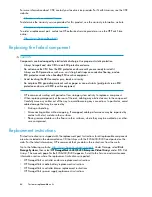
Example 1. Saving configuration data using SSSU on a Windows Host
To save the storage system configuration:
1.
Double-click on the SSSU desktop icon to run the application. When prompted, enter Manager
(management server name or IP address), User name, and Password.
2.
Enter
LS SYSTEM
to display the EVA storage systems managed by the management server.
3.
Enter
SELECT SYSTEM system name
, where
system name
is the name of the storage system.
4.
Enter
CAPTURE CONFIGURATION pathname\filename
, where
pathname
identifies the loc-
ation where the configuration files will be saved, and
filename
is the name used as the prefix
for the configurations files: for example,
CAPTURE CONFIGURATION c:\EVAConfig\Lar-
geEVA
5.
Enter
EXIT
to close the command window.
Example 2. Restoring configuration data using SSSU on a Windows Host
To restore the storage system configuration:
1.
Double-click on the SSSU desktop icon to run the application.
2.
Enter
FILE pathname\filename
, where
pathname
identifies the location where the configur-
ation files are to be saved and
filename
is the name of the first configuration file: for example,
FILE c:\EVAConfig\LargeEVA_Step1A.txt
3.
Repeat the preceding step for each configuration file.
Adding disk drives to the storage system
As your storage requirements grow, you may be adding disk drives to your storage system. Adding
new disk drives is the easiest way to increase the storage capacity of the storage system. Disk drives
can be added online without impacting storage system operation.
Creating disk groups
The new disks you add will typically be used to create new disk groups. Although you cannot select
which disks will be part of a disk group, you can control this by building the disk groups sequentially.
Add the disk drives required for the first disk group, and then create a disk group using these disk
drives. Now add the disk drives for the second disk group, and then create that disk group. This
process gives you control over which disk drives are included in each disk group.
NOTE:
Standard and FATA disk drives must be in separate disk groups. Disk drives of different capacities
and spindle speeds can be included in the same disk group, but you may want to consider separating
them into separate disk groups.
Handling fiber optic cables
This section provides protection and cleaning methods for fiber optic connectors.
Contamination of the fiber optic connectors on either a transceiver or a cable connector can impede
the transmission of data. Therefore, protecting the connector tips against contamination or damage
is imperative. The tips can be contaminated by touching them, by dust, or by debris. They can be
damaged when dropped. To protect the connectors against contamination or damage, use the dust
HP StorageWorks 6400/8400 Enterprise Virtual Array user guide
53
Содержание 6400/8400
Страница 12: ...12 ...
Страница 16: ...About this guide 16 ...
Страница 60: ...EVA6400 8400 operation 60 ...
Страница 66: ...Customer replaceable units 66 ...
Страница 80: ...Error messages 80 ...
Страница 92: ...Regulatory notices and specifications 92 ...






























